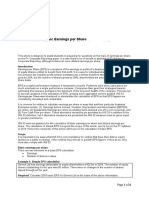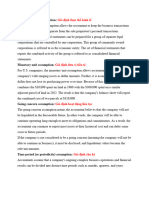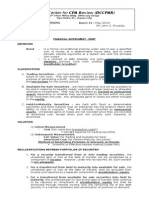Graham Number Definition
Uploaded by
rony chidiacGraham Number Definition
Uploaded by
rony chidiacEDUCATION MARKETS SIMULATOR YOUR MONEY ADVISORS ACADEMY
FUNDAMENTAL ANALYSIS TOOLS FOR FUNDAMENTAL ANALYSIS
Fundamental Graham Number
Analysis
By ADAM HAYES | Reviewed by ROGER WOHLNER | Updated May 10, 2021
TOOLS FOR FUNDAMENTAL
ANALYSIS
What Is the Graham Number?
SECTORS & INDUSTRIES The Graham number (or Benjamin Graham's number) measures a stock's
ANALYSIS
fundamental value by taking into account the company's earnings per share (EPS)
and book value per share (BVPS).
The Graham number is the upper bound of the price range that a defensive
investor should pay for the stock. According to the theory, any stock price below
the Graham number is considered undervalued and thus worth investing in.
KEY TAKEAWAYS
The Graham number is a metric to determine the highest price that an
investor should pay for a particular stock.
It was developed by legendary value investor Benjamin Graham.
The number is arrived at using a company's earnings and book value,
both on a per-share basis.
The Graham number is normalized by a factor of 22.5, to represent an
'ideal' P/E ratio of no more than 15x and a P/B of 1.5x.
The Formula for Graham's Number
22.5 × (earnings per share) × (book value per share)
Where:
Earnings per share (EPS) is calculated as a company's net profit divided by the
number of outstanding shares of its common stock.
Book value per share (BVPS) is the ratio of equity available to common
shareholders divided by the number of outstanding shares. This figure
represents the minimum value of a company's equity and measures the book
value of a firm on a per-share basis.
Understanding the Graham Number
The Graham number is named after the "father of value investing," Benjamin
Graham. It is used as a general test when trying to identify stocks that are currently
selling for a good price. The 22.5 figure is included in the calculation to account for
Graham's belief that the price-to-earnings (P/E) ratio should not be over 15x and
the price-to-book (P/B) ratio should not be over 1.5x (thus, 15 x 1.5 = 22.5).
The Graham number can thus be alternatively calculated as:
15 × 1.5 × ( shares outstanding
net income
) × ( shareholders’ equity
shares outstanding
)
Essentially, this second method of calculation is equivalent to the first,
wherein EPS = net income/shares outstanding, and book value is another term for
shareholders’ equity.
FAST FACT
Current price should not be more than 1 1/2 times the book value
last reported. However, a multiplier of earnings below 15 could
justify a correspondingly higher multiplier of assets. As a rule of
thumb, we suggest that the product of the multiplier times the ratio
of price to book value should not exceed 22.5. —Benjamin Graham,
The Intelligent Investor (Ch. 14)
Example of a Graham Number
For example, if the earning per share for a single share of company ABC is $1.50,
the book value per share is $10, the Graham number would be 18.37.
((22.5*1.5*10)= 18.37). Again, $18.37 is the maximum price an investor should pay
for a share of ABC, according to Graham. If ABC is priced at $16, it is attractive; if
priced at $19, it should be avoided.
Limitations of the Graham Number
The calculation for the Graham number does leave out many fundamental
characteristics, which are considered to comprise a good investment, such as
management quality, major shareholders, industry characteristics, and the
competitive landscape.
With regard to stocks and equity instruments, fundamental analysis is a method of
determining value that focuses on key metrics and economic indicators, such as
revenues, earnings, where an industry is in its cycle, return on equity (ROE), and
profit margins.
Fundamental analysis relies on a company’s financial statements. One of the most
famous and successful fundamental analysts, Warren Buffett—aka "the Oracle of
Omaha"—is famous for successfully employing fundamental analysis. Warren
Buffett was both a student and employee of Benjamin Graham. The fundamental
method of security analysis is considered to be the opposite of technical analysis.
Frequently Asked Questions
What is a good Graham's number?
Graham's number will always present a maximum stock price given a company's
EPS and BVPS. As a result, any stock price below that figure should signal a good
buy for a value investor.
What is the Graham number in value investing?
The Graham number takes a company's per-share metrics and normalizes it based
on a recommended upward limit for value investors of 15x P/E and 1.5x P/B.
Who was Benjamin Graham?
Benjamin Graham is one of the founding fathers of value investing, and a financial
guru to many famous value investors such as Warren Buffett. Graham's philosophy
was to closely examine a company's financial statements to identify undervalued
opportunities. His book, “The Interpretation of Financial Statements” is widely
regarded as foundational for value investing.
Related Terms
Value Investing: How to Invest Like Warren Buffett
Value investors like Warren Buffett select undervalued stocks trading at less than their
intrinsic book value that have long-term potential. more
What the Price-To-Book Ratio (P/B Ratio) Tells You?
The price-to-book ratio (P/B ratio) evaluates a firm's market value relative to its book
value. more
Net-Net
Net-net is a value investing technique developed by Benjamin Graham in which a company
is valued based solely on its net current assets. more Partner Links
Book Value
An asset's book value is equal to its carrying value on the balance sheet, and companies
calculate it by netting the asset against its accumulated depreciation. more
Benjamin Method
The investment approach that aims to follow the strategies implemented by Benjamin
Graham. more
Book Value Per Common Share
Book value per common share (BVPS) derives a company's book value on a per-share
basis. more
Related Articles
FINANCIAL RATIOS
Understand the Weaknesses of the
Price-to-Book (P/B) Ratio
FUNDAMENTAL ANALYSIS
What Does a "N/A" P/E Ratio Mean?
FINANCIAL RATIOS
Using Ratios to Determine If a Stock Is
Overvalued or Undervalued
FINANCIAL RATIOS
Can Investors Trust the P/E Ratio?
STOCK TRADING STRATEGY & EDUCATION
Digging Into Book Value
FUNDAMENTAL ANALYSIS
Analyzing Retail Stocks
About Us Terms of Use Dictionary
Editorial Policy Advertise News
Privacy Policy Contact Us Careers
TRUSTe California Privacy
Notice
# A B C D E F G H I J K L M N O P Q R S T U V W X Y Z
Investopedia is part of the Dotdash publishing family.
You might also like
- FRK 111 2018 Module Test 1 - Suggested SolutionNo ratings yetFRK 111 2018 Module Test 1 - Suggested Solution6 pages
- The True Way To Use The Graham Number and Formula PDFNo ratings yetThe True Way To Use The Graham Number and Formula PDF5 pages
- Market-Based Valuation: Price MultiplesNo ratings yetMarket-Based Valuation: Price Multiples47 pages
- Financial Ratios For Valuation (Cir. 26.9.2023)No ratings yetFinancial Ratios For Valuation (Cir. 26.9.2023)58 pages
- Graham Number and Warren Buffett PortfolioNo ratings yetGraham Number and Warren Buffett Portfolio2 pages
- Equity Valuation: Why Determine Value of A StockNo ratings yetEquity Valuation: Why Determine Value of A Stock12 pages
- Rediscovering Benjamin Graham, by Janet Lowe, Better Investing Aug 1994No ratings yetRediscovering Benjamin Graham, by Janet Lowe, Better Investing Aug 19943 pages
- Market Based Valuation and EV MultiplesNo ratings yetMarket Based Valuation and EV Multiples76 pages
- Determinats of Share Price With ReferencNo ratings yetDeterminats of Share Price With Referenc16 pages
- Definition of Profitability: Profitability Is The Ability of A Business To Earn A Profit. A Profit Is What IsNo ratings yetDefinition of Profitability: Profitability Is The Ability of A Business To Earn A Profit. A Profit Is What Is7 pages
- Valuation Methods Used in Mergers & Acquisition: Roshankumar S PimpalkarNo ratings yetValuation Methods Used in Mergers & Acquisition: Roshankumar S Pimpalkar6 pages
- Chapter. 1 Introduction of Valuation of Share: Financial Markets StocksNo ratings yetChapter. 1 Introduction of Valuation of Share: Financial Markets Stocks30 pages
- Valuation Methods Used in Mergers & Acquisition: Roshankumar S PimpalkarNo ratings yetValuation Methods Used in Mergers & Acquisition: Roshankumar S Pimpalkar6 pages
- Stock Valuation: Fundamental Criteria (Fair Value)No ratings yetStock Valuation: Fundamental Criteria (Fair Value)7 pages
- Unit - Iv Valuation of Shares and Goodwill What Is Share Valuation?No ratings yetUnit - Iv Valuation of Shares and Goodwill What Is Share Valuation?56 pages
- Final Docs of Insurance and Asset ManagementNo ratings yetFinal Docs of Insurance and Asset Management105 pages
- Siti Maisarah Share Valuation AssignmentNo ratings yetSiti Maisarah Share Valuation Assignment20 pages
- 8 Keys Ratios To Look at Before Buying A ShareNo ratings yet8 Keys Ratios To Look at Before Buying A Share10 pages
- The Role of Profitability and Leverage in Determining Indonesia's Companies Stock PricesNo ratings yetThe Role of Profitability and Leverage in Determining Indonesia's Companies Stock Prices10 pages
- Beyond Earnings: Applying the HOLT CFROI and Economic Profit FrameworkFrom EverandBeyond Earnings: Applying the HOLT CFROI and Economic Profit FrameworkNo ratings yet
- Oligarchy - Definition & Facts - BritannicaNo ratings yetOligarchy - Definition & Facts - Britannica1 page
- Confederation Vs Federation - Difference and Comparison - DiffenNo ratings yetConfederation Vs Federation - Difference and Comparison - Diffen1 page
- Lebanese Entrepreneur Jean Nehmé Sold His Startup For USD 500 MillionNo ratings yetLebanese Entrepreneur Jean Nehmé Sold His Startup For USD 500 Million1 page
- One-Year Master's Courses - Non-EU Citizens Living Outside Italy - International - Unitn.itNo ratings yetOne-Year Master's Courses - Non-EU Citizens Living Outside Italy - International - Unitn.it1 page
- File - Oil and Gas Industry Reserves by Nation - PNG - Wikimedia CommonsNo ratings yetFile - Oil and Gas Industry Reserves by Nation - PNG - Wikimedia Commons1 page
- Top Free Sites To Download Books - Google SearchNo ratings yetTop Free Sites To Download Books - Google Search1 page
- Advanced Master in Maritime Engineering - Transport, Energy, Sustainable Development - ENSTA Paris, Grande École D'ingénieurs GénéralisteNo ratings yetAdvanced Master in Maritime Engineering - Transport, Energy, Sustainable Development - ENSTA Paris, Grande École D'ingénieurs Généraliste1 page
- Aavas Finance Company: Career Aavas Loan App Contact Us About UsNo ratings yetAavas Finance Company: Career Aavas Loan App Contact Us About Us4 pages
- Financial Derivatives With Blockchain and Smart Contracts: Massimo MoriniNo ratings yetFinancial Derivatives With Blockchain and Smart Contracts: Massimo Morini20 pages
- Class 10 Economics Chapter 3 Questions and Answers Money and CreditNo ratings yetClass 10 Economics Chapter 3 Questions and Answers Money and Credit11 pages
- CA Foundation Accounts A MTP 1 June 2024 Castudynotes ComNo ratings yetCA Foundation Accounts A MTP 1 June 2024 Castudynotes Com14 pages
- Mergers, Lbos, Divestitures, and Holding CompaniesNo ratings yetMergers, Lbos, Divestitures, and Holding Companies65 pages






































































































